Abstract
The aim of this study was to evaluate the effect of acetazolamide on cerebral blood flow (CBF) and cerebral metabolic rate for oxygen (CMRO2). CBF, arterial and jugular venous partial O2 pressure, partial CO2 pressure, pH, and O2 saturation percentage were measured in six patients before and 3 and 20 minutes after intravenous administration of 1 g of acetazolamide. CBF was measured by the intracarotid 133xenon injection technique. In addition, changes in CBF were estimated from the arteriovenous oxygen content difference. CBF increased in all patients after acetazolamide, by approximately 55 and 70% after 3 and 20 min, respectively. The CBF changes were of the same order whether calculated from the 133Xe clearance or from the arteriovenous oxygen differences (A-V)O2. CMRO2, calculated from (A-V)O2 differences and CBF, remained constant. Except for an increase in the venous oxygen saturation, the blood gases remained constant. Acetazolamide, in a dose sufficient to inhibit the erythrocyte carbonic anhydrase (EC 4.2.1.1), thus induced a rapid and marked increase in CBF, leaving CMRO2 unchanged. This effect of acetazolamide on CBF is probably explained by a decrease in brain pH rather than by brain tissue hypoxia due to inhibition of oxygen unloading in the brain capillaries.
Full text
PDF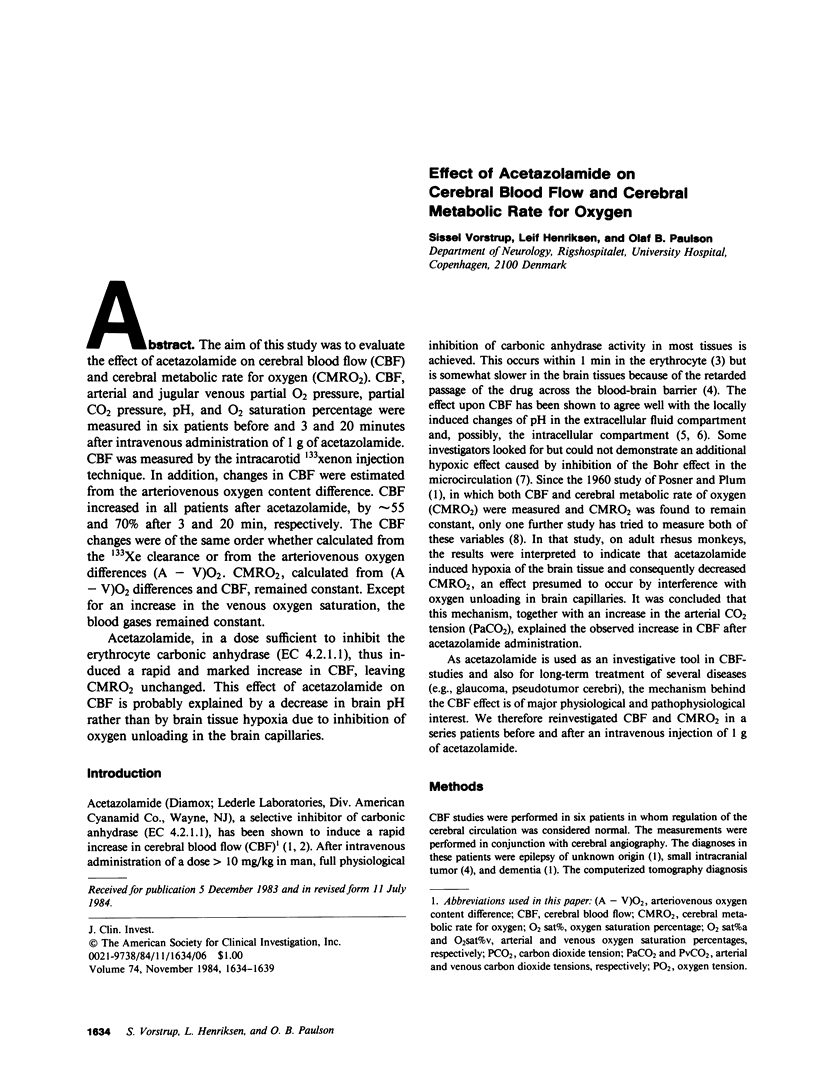
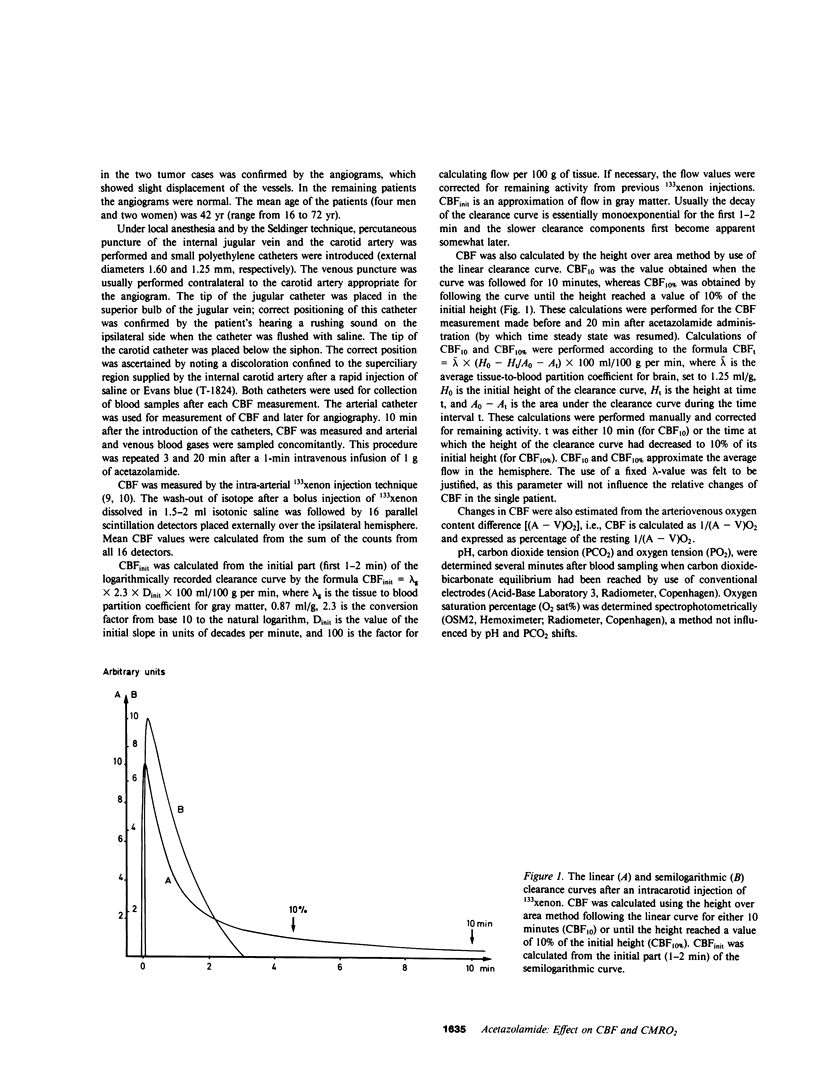
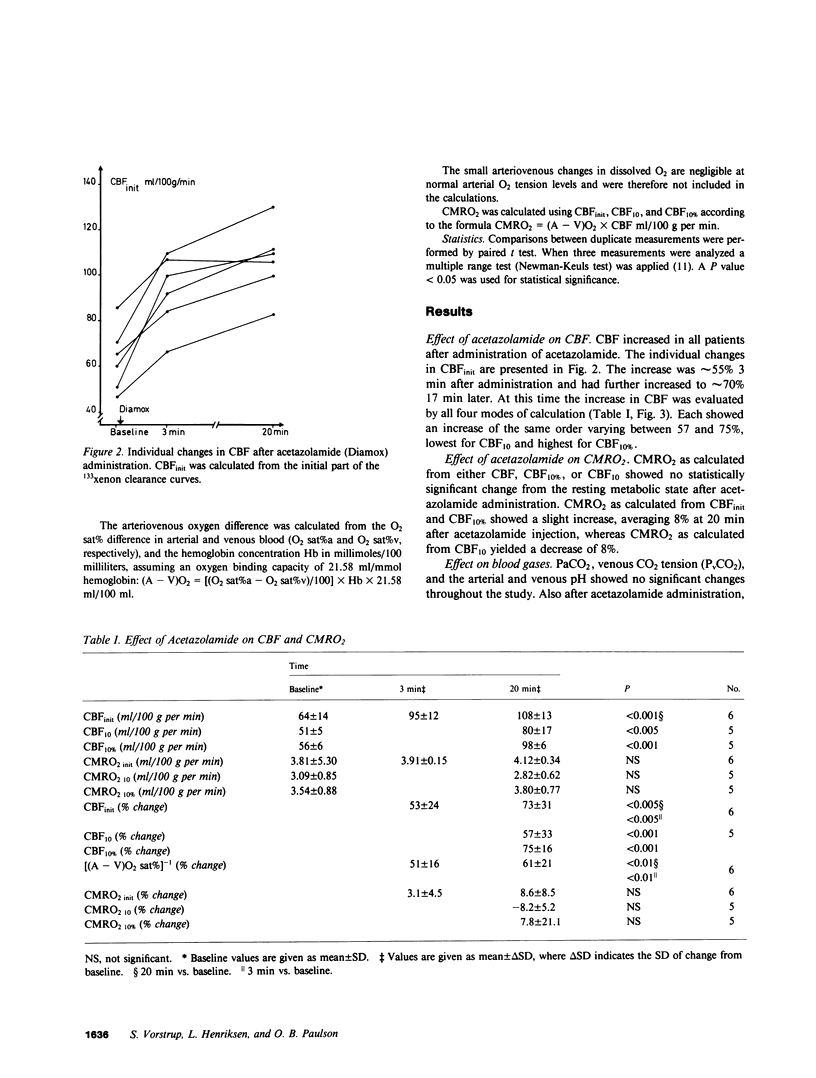
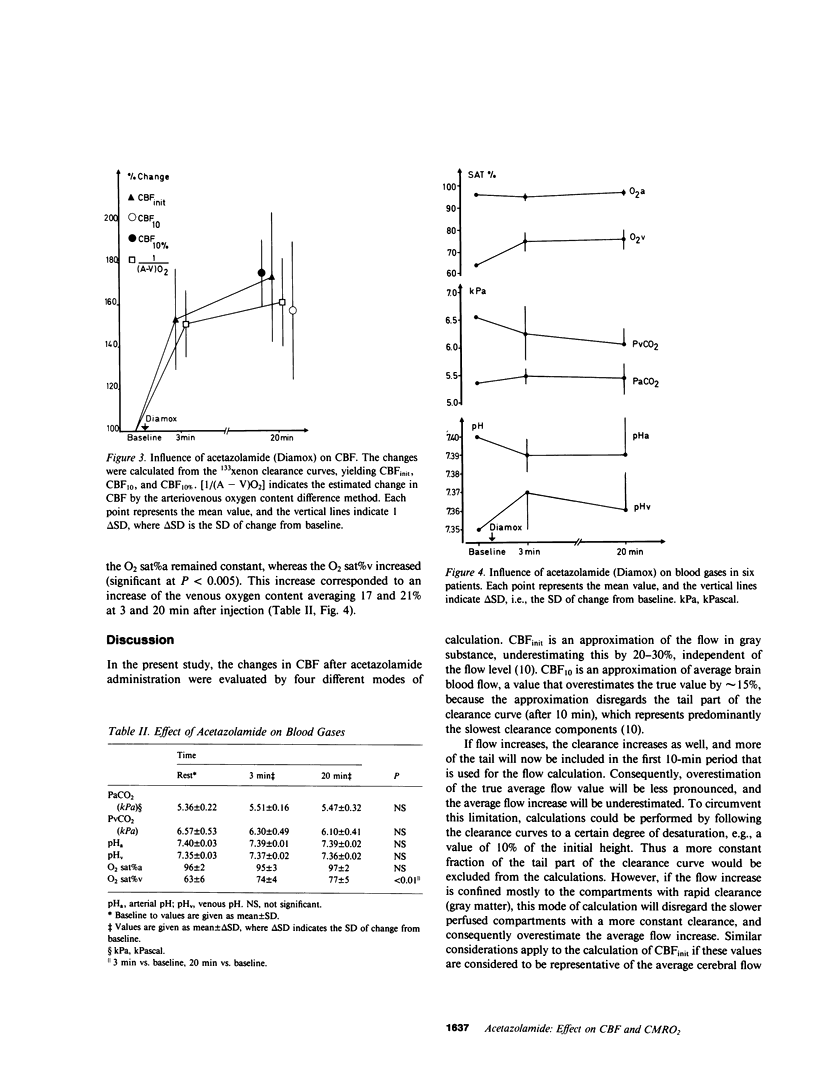
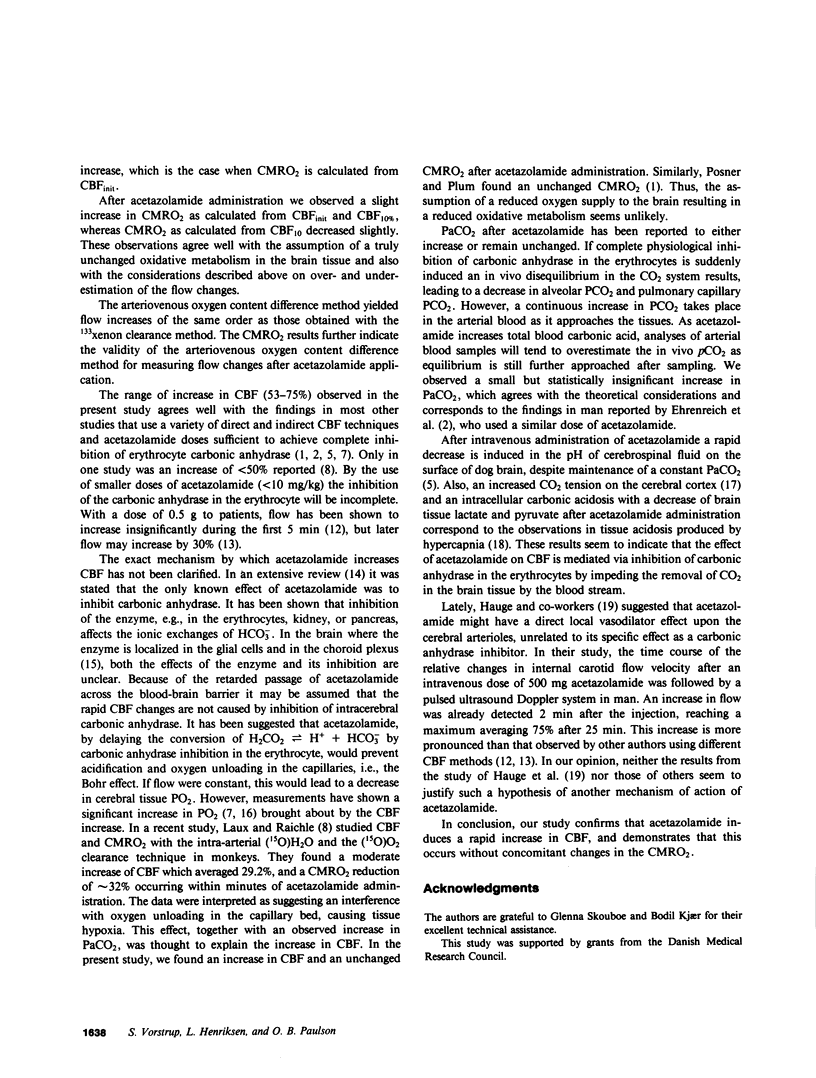
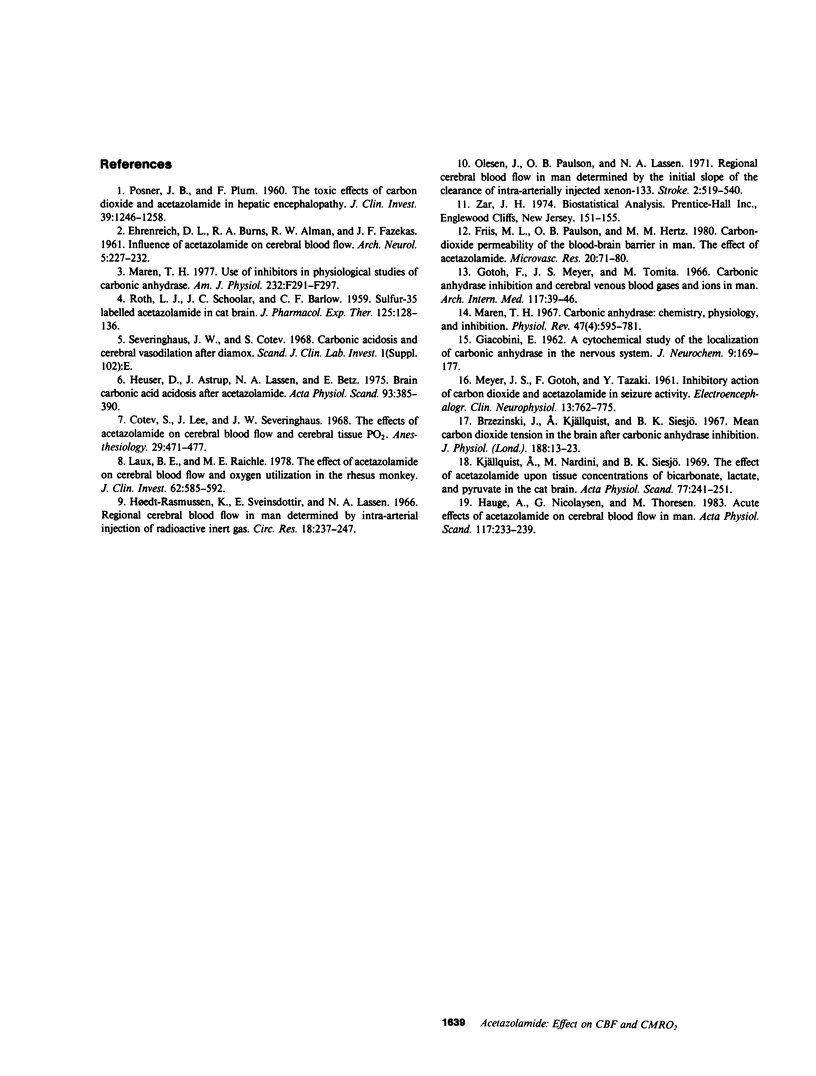
Selected References
These references are in PubMed. This may not be the complete list of references from this article.
- Brzezinski J., Kjällquist A., Siesjö B. K. Mean carbon dioxide tension in the brain after carbonic anhydrase inhibition. J Physiol. 1967 Jan;188(1):13–23. doi: 10.1113/jphysiol.1967.sp008120. [DOI] [PMC free article] [PubMed] [Google Scholar]
- Cotev S., Lee J., Severinghaus J. W. The effects of acetazolamide on cerebral blood flow and cerebral tissue PO2. Anesthesiology. 1968 May-Jun;29(3):471–477. doi: 10.1097/00000542-196805000-00018. [DOI] [PubMed] [Google Scholar]
- EHRENREICH D. L., BURNS R. A., ALMAN R. W., FAZEKAS J. F. Influence of acetazolamide on cerebral blood flow. Arch Neurol. 1961 Aug;5:227–232. doi: 10.1001/archneur.1961.00450140109011. [DOI] [PubMed] [Google Scholar]
- Friis M. L., Paulson O. B., Hertz M. M. Carbon dioxide permeability of the blood-brain barrier in man. The effect of acetazolamide. Microvasc Res. 1980 Jul;20(1):71–80. doi: 10.1016/0026-2862(80)90020-5. [DOI] [PubMed] [Google Scholar]
- GIACOBINI E. A cytochemical study of the localization of carbonic anhydrase in the nervous system. J Neurochem. 1962 Mar-Apr;9:169–177. doi: 10.1111/j.1471-4159.1962.tb11859.x. [DOI] [PubMed] [Google Scholar]
- Gotoh F., Meyer J. S., Tomita M. Carbonic anhydrase inhibition and cerebral venous blood gases and ions in man. Demonstration of increased oxygen availability to ischemic brain. Arch Intern Med. 1966 Jan;117(1):39–46. [PubMed] [Google Scholar]
- Hauge A., Nicolaysen G., Thoresen M. Acute effects of acetazolamide on cerebral blood flow in man. Acta Physiol Scand. 1983 Feb;117(2):233–239. doi: 10.1111/j.1748-1716.1983.tb07202.x. [DOI] [PubMed] [Google Scholar]
- Heuser D., Astrup J., Lassen N. A., Betz B. E. Brain carbonic acid acidosis after acetazolamide. Acta Physiol Scand. 1975 Mar;93(3):385–390. doi: 10.1111/j.1748-1716.1975.tb05827.x. [DOI] [PubMed] [Google Scholar]
- Hoedt-Rasmussen K., Sveinsdottir E., Lassen N. A. Regional cerebral blood flow in man determined by intra-arterial injection of radioactive inert gas. Circ Res. 1966 Mar;18(3):237–247. doi: 10.1161/01.res.18.3.237. [DOI] [PubMed] [Google Scholar]
- Kjällquist A., Nardini M., Siesjö B. K. The effect of acetazolamide upon tissue concentrations of bicarbonate, lactate, and pyruvate in the rat brain. Acta Physiol Scand. 1969 Sep-Oct;77(1):241–251. doi: 10.1111/j.1748-1716.1969.tb04568.x. [DOI] [PubMed] [Google Scholar]
- Laux B. E., Raichle M. E. The effect of acetazolamide on cerebral blood flow and oxygen utilization in the rhesus monkey. J Clin Invest. 1978 Sep;62(3):585–592. doi: 10.1172/JCI109164. [DOI] [PMC free article] [PubMed] [Google Scholar]
- Maren T. H. Carbonic anhydrase: chemistry, physiology, and inhibition. Physiol Rev. 1967 Oct;47(4):595–781. doi: 10.1152/physrev.1967.47.4.595. [DOI] [PubMed] [Google Scholar]
- Maren T. H. Use of inhibitors in physiological studies of carbonic anhydrase. Am J Physiol. 1977 Apr;232(4):F291–F297. doi: 10.1152/ajprenal.1977.232.4.F291. [DOI] [PubMed] [Google Scholar]
- Olesen J., Paulson O. B., Lassen N. A. Regional cerebral blood flow in man determined by the initial slope of the clearance of intra-arterially injected 133Xe. Stroke. 1971 Nov-Dec;2(6):519–540. doi: 10.1161/01.str.2.6.519. [DOI] [PubMed] [Google Scholar]
- POSNER J. B., PLUM F. The toxic effects of carbon dioxide and acetazolamide in hepatic encephalopathy. J Clin Invest. 1960 Aug;39:1246–1258. doi: 10.1172/JCI104140. [DOI] [PMC free article] [PubMed] [Google Scholar]
- ROTH L. J., SCHOOLAR J. C., BARLOW C. F. Sulfur-35 labeled acetazolamide in cat brain. J Pharmacol Exp Ther. 1959 Feb;125(2):128–136. [PubMed] [Google Scholar]


